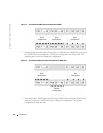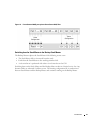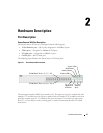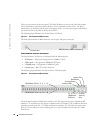
32 Introduction
www.dell.com | support.dell.com
Fast Link
STP can take up to 30-60 seconds to converge. During this time, STP detects possible loops,
allowing time for status changes to propagate and for relevant devices to respond. 30-60 seconds is
considered too long of a response time for many applications. The Fast Link option bypasses this
delay, and can be used in network topologies where forwarding loops do not occur.
For more information enabling Fast Link for ports and LAGs, see "Defining STP Port Settings"
or
"
Defining Static Addresses."
IEEE 802.1w Rapid Spanning Tree
Spanning Tree can take 30-60 seconds for each host to decide whether its ports are actively
forwarding traffic. Rapid Spanning Tree (RSTP) detects uses of network topologies to enable faster
convergence, without creating forwarding loops.
For more information, see "Defining Rapid Spanning Tree."
IEEE 802.1s Multiple Spanning Tree
Multiple Spanning Tree (MSTP) operation maps VLANs into STP instances. MSTP provides
differing load balancing scenario. Packets assigned to various VLANs are transmitted along different
paths within MSTP Regions (MST Regions). Regions are one or more MSTP bridges by which
frames can be transmitted. The standard lets administrators assign VLAN traffic to unique paths.
For more information, see "Configuring the Spanning Tree Protocol".
Link Aggregation
Link Aggregation
Up to eight Aggregated Links may be defined, each with up to eight member ports, to form a single
Link Aggregated Group (LAG). This enables:
• Fault tolerance protection from physical link disruption
• Higher bandwidth connections
• Improved bandwidth granularity
• High bandwidth server connectivity
LAG is composed of ports with the same speed, set to full-duplex operation.
For more information, see "Defining LAG Parameters."
Link Aggregation and LACP
LACP uses peer exchanges across links to determine, on an ongoing basis, the aggregation
capability of various links, and continuously provides the maximum level of aggregation capability
achievable between a given pair of devices. LACP automatically determines, configures, binds, and
monitors the port binding within the system.
For more information, see "Aggregating Ports."


















